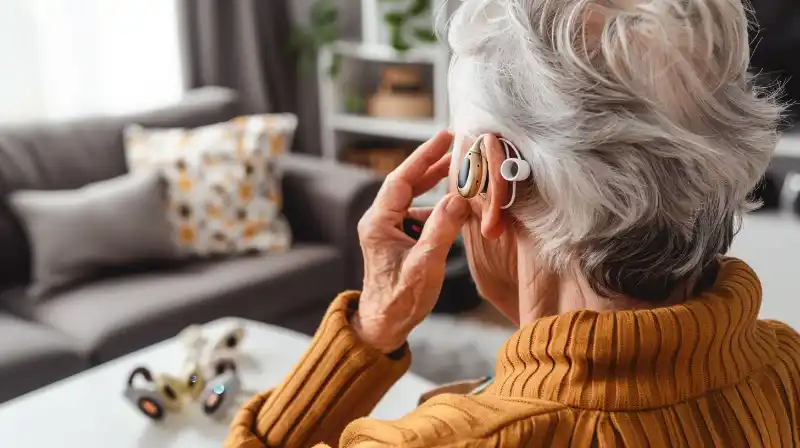Struggling to hear can make life challenging, especially for seniors. Forbes Health suggests that the latest hearing aids could transform this daily struggle. This article will guide you through innovative options and what to consider when choosing a hearing aid, making the decision simpler.
Discover sensational sound again!
Key Takeaways
- New hearing aids with advanced features like noise reduction and Bluetooth streaming are helping seniors hear better in noisy environments.
- There are different types of hearing aids to choose from, each fitting differently and offering unique benefits for discreetness and sound quality.
- The cost of hearing aids varies widely, with over-the-counter options being more affordable than prescription devices that offer professional support and custom fitting.
- Dr. Linda Horowitz emphasizes the importance of gradual adjustment to new hearing aids and acknowledges potential challenges such as battery life issues.
- These innovative devices not only enhance sound but also improve overall quality of life for seniors experiencing hearing difficulties.
How Hearing Aids Work: A Brief Overview

Hearing aids can be truly life-changing for you or your loved ones experiencing hearing loss. These small but powerful devices amplify sound through a simple yet sophisticated process, tailored to individual needs.
They consist of a microphone that picks up sounds from your environment, an amplifier that increases the volume of these sounds, and a speaker that delivers the amplified sound into your ear.
The technology behind hearing aids has advanced significantly; they now use digital processing to manage noise and enhance speech understanding. This means they’re more than just volume boosters—they smartly distinguish between types of sound to provide clearer audio.
With settings adjustable by audiologists and some models even programmable via smartphone apps, modern hearing aids are designed to seamlessly integrate into daily life while offering user-friendly interfaces.
Whether attending family gatherings or enjoying television at home, today’s devices help alleviate the strain of strained listening and reconnect individuals with their auditory world.
Selecting the Right Hearing Aid for Seniors: Factors to Consider

When seniors embark on the journey to improve their hearing, choosing the ideal aid is pivotal. It requires a careful assessment of their specific needs and preferences, ensuring that the device enhances not only their hearing but also integrates seamlessly into their everyday lives.
Compatibility with lifestyle needs
Your way of life is key in picking the right hearing aid. You might love chatting at dinner parties or need to hear well in quieter places. Look for hearing aids with features that match your daily activities.
If you’re active and outdoors a lot, find ones that handle wind noise and are water-resistant.
Think about what makes you comfortable too. Some people don’t mind devices that sit behind-the-ear (BTE), while others prefer nearly invisible, completely-in-the-canal (CIC) options.
Ease of use matters as well—larger models are often easier to handle if you have dexterity issues. Choose a hearing aid that fits not just your ear, but also your lifestyle!
Available features
Hearing aids today come packed with incredible features. They offer Bluetooth capabilities, which means you can connect them directly to your iPhone or other devices. You’ll enjoy crystal-clear phone calls and music streaming right in your ears! Devices also boast advanced noise reduction for better sound quality in busy places.
Some models include rechargeable batteries, so no more fussing with tiny battery changes. Imagine charging your hearing aid just like a smartphone, simple and efficient. Telecoils are another standout feature; they let you hear better during telephone conversations and in venues equipped with special sound systems.
Plus, if ringing in the ears is an issue, look for tinnitus management options that provide relief from that constant noise.
Cost and insurance considerations
Hearing aids can be a big investment, with prices ranging from $1,500 to several thousand dollars each. It’s important to look beyond the initial price tag and consider professional fees, remote controls, and accessories that might add to the cost.
Some seniors may find affordable options between $200 and $7,000 per pair depending on what features they need. However, the typical cost for these devices is often between $4,000 and $5,000.
Insurance can play a big role in managing these expenses. Check if your plan covers hearing aids or if you qualify for benefits under Medicare Advantage plans. Discounts through veterans affairs or financing options like health savings accounts could also help lower costs.
Remember that investing in quality hearing aids isn’t just about clearer sound—it’s also about improving your overall quality of life.
Top Hearing Aids for Seniors in 2024
The latest hearing aids offer amazing features that can change the game for seniors. In 2024, brands like Phonak, Widex, and Starkey are bringing out devices with top-notch sound quality and advanced technology.
Many of these new hearing aids come with Bluetooth streaming, smart speech technology, and rechargeable batteries. They are designed to help seniors stay connected and enjoy clearer conversations.
Seniors looking for new hearing aids should check out models with directional microphones and feedback cancellation systems. These features cut down on background noise so you can focus on what you want to hear.
Some models even have fall detection or tinnitus masking built-in, adding an extra layer of health benefits. The best part is that finding the right device has become easier thanks to online hearing tests and over-the-counter options available at many stores.
Jabra Enhance Select 300: A Sensational Choice for Seniors
The Jabra Enhance Select 300 is turning heads in the senior community with its advanced features tailored for effortless hearing enhancement. This device epitomizes cutting-edge technology, providing seniors with an empowering solution to tackle age-related hearing loss.
Features & Description (Jabra Enhance Select 300)
Jabra Enhance Select 300 makes listening easier for seniors. Its smart microphones and powerful processor deliver clear, natural sound. Even in loud places, you can hear well because it cuts down background noise.
This hearing aid is also rechargeable and 9% smaller than older models, so it’s easy to handle.
You’ll love the mini design that fits nicely in your ear for all-day comfort. Plus, with Bluetooth streaming, you can take hands-free calls or listen to music directly from smartphones or other devices.
Enjoy true depth of sound and stay connected with ease using the Jabra Enhance Select 300 hearing aids.
Pros & Cons (Jabra Enhance Select 300)
The Jabra Enhance Select 300 makes it easy for you to enjoy phone calls and music with Bluetooth streaming, especially if you have an iPhone. These hearing aids focus on the sounds you want to hear by working together; this is known as binaural directionality.
You won’t need wires or extra devices to take a call, which keeps things simple.
However, some seniors might find these features less beneficial if they don’t use smartphones often. Also, the hearing aids may be costly without insurance coverage. Before deciding, consider how much value the special functions add to your daily life versus their price tag.
Oticon Real: Offering Real Results for Seniors
Experience the difference with Oticon Real, the advanced hearing solution specifically engineered to provide seniors with clarity and comfort. This innovative device harnesses cutting-edge technology to enhance auditory perception, transforming everyday listening into a truly effortless encounter.
Features & Description (Oticon Real)
Oticon Real hearing aids use the latest sound technology to help you hear better. They have a special system that makes speech clear and easy to understand. This is because they use something called Deep Neural Network (DNN), which learned from 12 million sounds in real life.
So, your brain gets more information to work with.
These hearing aids are great for connecting with different devices too. You can connect them to your phone or tablet using Bluetooth. With Oticon Real, you get two styles to choose from, so you can pick the best fit for your ears and lifestyle.
Enjoy talking with friends and listening to music again without missing out on any of the sounds around you!
Pros & Cons (Oticon Real)
The Oticon Real hearing aid makes listening easier. It sharpens sounds, letting your brain hear speech clearly even in busy places. This device fits comfortably behind the ear and is hardly noticeable.
With this hearing aid, you can trust that noises will sound balanced and real, helping you stay focused.
Yet, these high-quality features come at a cost, which might be higher than some other brands. The Oticon Real needs to be programmed by an expert based on your unique hearing test results.
Make sure it’s within budget and consider if insurance covers the expenses before choosing this option.
Eargo 7: The Future of Hearing Aids for Seniors
The Eargo 7 emerges as a trailblazer in auditory assistance, offering seniors an innovative solution that promises to redefine the future of hearing aids. With cutting-edge design and advanced sound technology, it stands poised to deliver unparalleled hearing support for those looking to enhance their listening experiences.
Features & Description (Eargo 7)
Eargo 7 is changing the game for seniors with its high-tech features. You get a self-fitting, over-the-counter hearing aid that’s both small and comfy. Imagine a device that’s almost invisible in your ear, but powerful enough to help you hear clearly.
Eargo 7 uses Sound Adjust+ with Clarity Mode, so it learns how you like to hear and adjusts automatically.
This hearing aid has a unique breathable tip designed just for your comfort. And don’t worry about batteries because Eargo 7 comes with an easy-to-use charger. Enjoy better hearing all day long without the hassle of replacing tiny batteries! Plus, its advanced artificial intelligence helps keep sounds clear even in noisy places.
Pros & Cons (Eargo 7)
Eargo 7 hearing aids are nearly invisible in your ears. This can make you feel more confident while wearing them. They come with Sound Adjust+ and Clarity Mode, making sounds clearer for mild to moderate hearing loss.
These devices are also over-the-counter (OTC), so it’s easy for you to get them without a doctor’s visit.
However, Eargo 7 is not water-resistant; keep them dry to avoid damage. They may be the most affordable model from Eargo, but they might not fit everyone’s needs or budget. Always check these details before deciding if Eargo 7 is right for you.
Lexie B2: Self-Fitting and User-Friendly
The Lexie B2 hearing aid emerges as a standout solution for seniors seeking self-sufficiency in their auditory health, boasting a design that prioritizes ease of use and personal customization.
This innovative device combines the convenience of self-fitting capabilities with user-friendly features, simplifying the journey toward improved hearing.
Features & Description (Lexie B2)
Lexie B2 Plus OTC hearing aids bring you clear sound at a price that makes sense. They are designed by Bose, so you know the quality is top-notch. These hearing devices easily fit in your ear and work well for mild to moderate hearing loss.
You can connect them to your iPhone using Bluetooth, making it easy to take calls or listen to music.
Charging these hearing aids is simple with the included case. This means less worry about running out of power when you need them most. They also have noise reduction features that help block out unwanted sounds around you.
With Lexie B2, enjoy crisp conversations and your favorite TV shows without strain. And since they’re over-the-counter (OTC) hearing aids, getting them is hassle-free—no extra doctor visits needed!
Pros & Cons (Lexie B2)
The Lexie B2 Plus hearing aids offer great sound processing at a price of $999, which is less than many other over-the-counter devices. They come with multiple dome sizes and an ear-measuring tool for a good fit.
These hearing aids are rechargeable and let you take an in-app hearing test to adjust them just right for your ears.
On the downside, some users find the Lexie B2’s design too big and not very comfortable. Also, even though they’re made by Bose and have helpful features, being noticed wearing them might bother you.
Remembering to charge them regularly is important if you don’t want them to run out of power when needed.
Phonak Lyric: The Invisible Hearing Aid
Phonak Lyric stands out for its revolutionary design that remains entirely hidden within the ear canal, offering both secrecy and superior sound quality to seniors. Its advanced technology facilitates a natural listening experience, redefining the standards of comfort and discretion in hearing aids.
Features & Description (Phonak Lyric)
The Lyric by Phonak is unique among hearing aids. It hides deep in your ear canal, where no one can see it. This tiny device works around the clock to help you hear clearly without any breaks.
Its soft foam material fits snugly and is designed to match your ear’s natural shape. You won’t even feel like you’re wearing a hearing aid.
This waterproof wonder stands out for how well it blends with your life. You can keep it in while talking on the phone, showering, or sleeping. Say goodbye to daily hassles of taking hearing aids out or changing batteries – Lyric is truly non-stop hearing comfort at its best! Plus, its clear sound quality feels just like natural hearing, making conversations easy again.
Pros & Cons (Phonak Lyric)
Phonak Lyric is a game-changer for seniors with its 100% invisible design. You can wear it all day without worry. It fits right in your ear canal, so no one knows you’re wearing a hearing aid.
Plus, they are waterproof, making them easy to handle during activities like showering or working out.
However, these incredible features come at a cost ranging from $3800-$4600 per pair. Also, because the Lyric is worn non-stop and deep within the ear canal, some users might experience discomfort or earwax buildup.
It’s important to consult an audiologist to see if this type of hearing aid suits your needs and lifestyle before making the investment.
A Deep Dive into Hearing Aid Types
To optimize your hearing experience, understanding the diverse array of hearing aid types is crucial; each designed with unique features tailored to various degrees of hearing loss and personal preferences.
This section will guide you through the intricate world of hearing aids, from those that nestle invisibly in your canal to sophisticated models that sit discreetly behind the ear.
Completely-in-the-canal (CIC) hearing aid
Completely-in-the-canal hearing aids are custom-made to fit inside your ear canal. They help with mild to moderately severe hearing loss. These devices are tiny and hard to see, making them a good choice if you want something discreet.
CIC hearing aids use advanced technology to reduce annoying echoes in your ears when you talk or chew.
They sit comfortably in the ear canal and need less power than larger models, which means the battery can last longer. Also, because they’re molded to your ear’s shape, they stay put better while talking or moving around.
If you prefer an aid that doesn’t show much and feels natural, consider these small but mighty devices for your hearing needs.
In-the-canal (ITC) hearing aid
In-the-canal hearing aids are made just for you. They fit deep inside your ear, so they’re barely noticeable. Seniors with mild to moderately severe hearing loss find these helpful.
The design helps make sure you don’t hear your own voice too loudly. These devices are custom-fit during a visit to an audiologist, ensuring comfort all day long.
ITC aids are tiny but pack a punch. They come equipped with features that can include bluetooth-enabled technology and water resistance. Some even have rechargeable batteries, making it easier to manage battery life without the hassle of frequent replacements.
Plus, their placement in the ear canal allows for natural sound processing, making conversations clearer and helping with single-sided hearing loss.
Behind-the-ear (BTE) hearing aid
Behind-the-ear (BTE) hearing aids have a plastic case that sits behind your ear. This case is attached to an earmold inside your ear by a clear tube. These devices are known for their power and flexibility in amplification.
BTE models can be a great choice if you need more volume or have severe hearing loss.
BTE hearing aids keep most of their parts tucked away in the small case behind your ear. They hook over the top, so they stay secure throughout the day. Many seniors choose BTE aids because they’re easier to handle and adjust than smaller styles.
If you’re active or enjoy talking with friends and family, this type of aid could help connect you to those sounds again.
Receiver-in-canal (RIC) hearing aid
Receiver-in-canal (RIC) hearing aids are great for seniors who need a powerful yet subtle device. These aids sit comfortably behind the ear, and they have a tiny wire connecting to a speaker inside the ear canal.
This makes them less noticeable than other types. They’re especially good at making high-pitched sounds clearer, which can help with understanding speech.
RIC models combine comfort with high performance. Since the loudspeaker is in your ear and not the case, it feels more natural when you’re wearing it. You might even forget it’s there! This style is ideal if you have mild to severe hearing loss but still want something that won’t stand out too much.
In-the-ear (ITE) hearing aid
In-the-ear hearing aids are custom-built just for you. They fit inside your ear and work to make sounds louder so you can hear better. These devices take up the shape of your ear’s bowl or nestle deep in your ear canal, where they’re hardly noticeable.
Unlike bigger models that fit behind your ear, ITE aids are more discreet.
These tiny helpers come with advanced tech to support your hearing needs. You get clear sound without a bulky device hanging around your ear. Since they are tucked away in your ear, many people won’t even know you’re wearing them.
And because they’re made to fit perfectly in your own ear, they stay put comfortably all day long.
Over-the-counter (OTC) vs Prescription Hearing Aids: What’s the Difference?
OTC hearing aids are a new choice for people with mild to moderate hearing problems. You can buy these without a prescription. They usually cost less, between $200 and $1,000 per pair.
OTC aids make it easy for you to get help with your hearing right away.
Prescription hearing aids need a visit to an expert. These experts will test your ears and pick the best aid for your needs. Prescription aids can help all types of hearing loss and have more features than OTC ones.
They can be expensive, starting at around $1,000 or more. But they also come with professional support and custom fitting.
FAQs
1. What are the new sensation hearing aids for seniors?
The new sensation hearing aids are rechargeable earbuds designed to help seniors with hearing loss. They use advanced technology from companies like Sonova and Starkey Laboratories.
2. Can these hearing aids help with different types of deafness?
Yes, they can assist people with various types of deafness, including sensorineural and conductive hearing loss, by amplifying sound.
3. Are these sensation hearing aids covered by health insurance or Medicare?
Some health insurance plans may cover them, as well as Medicare Part B and D in specific cases related to a medical necessity certified by doctors at healthcare systems or VA medical centers.
4. Do I need a prescription to get the sensation hearing aids?
No! These over-the-counter devices are available without a prescription following FDA’s guidelines so you can purchase them directly online or at stores.
5. How do I pay for these sensational earbuds if I’m on a budget?
You can use flexible payment options like debit cards, Medicaid benefits or funds from your Flexible Spending Account (FSA) to buy the affordable devices.
6. How do I know if my sound level needs adjustment on my sensory earbuds?
Your device might come with an integrated sound level meter that checks environmental noise levels for optimal adjustments, ensuring comfort and clarity.
Source Links
- https://www.forbes.com/health/hearing-aids/best-hearing-aids-for-seniors/
- https://www.nidcd.nih.gov/health/hearing-aids
- https://www.ncoa.org/adviser/hearing-aids/best-hearing-aids/
- https://www.professionalaudiologicalservices.com/tips-on-choosing-the-best-hearing-aids-for-seniors/
- https://www.miracle-ear.com/blog-news/best-hearing-aids-for-seniors-tips-advice
- https://www.usnews.com/360-reviews/services/best-hearing-aids
- https://www.consumerreports.org/health/hearing-aids/complete-guide-to-over-the-counter-hearing-aids-a3898239010/





